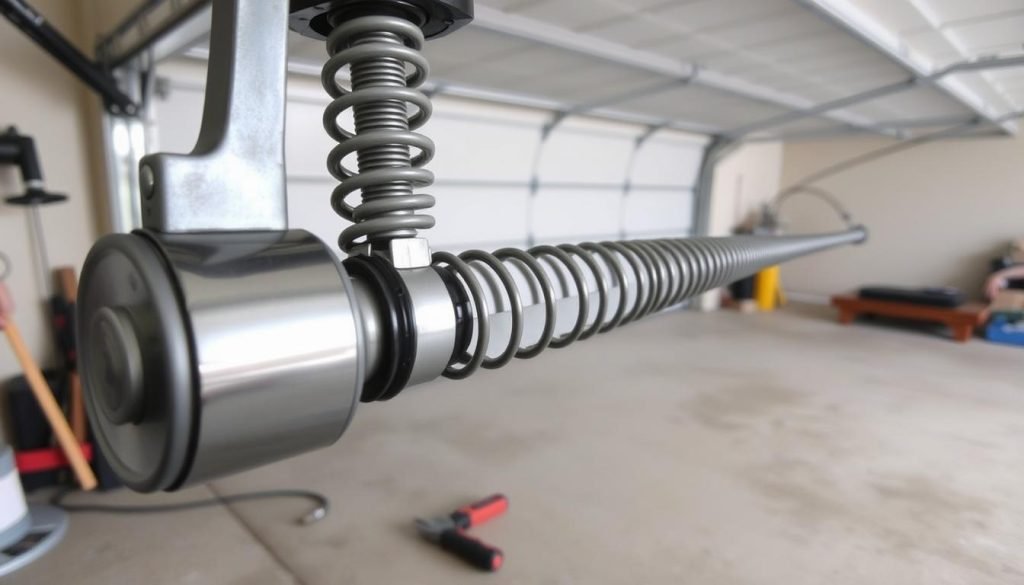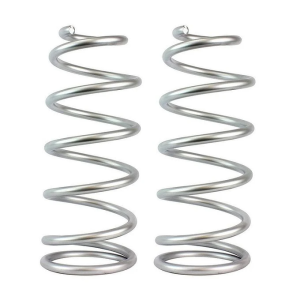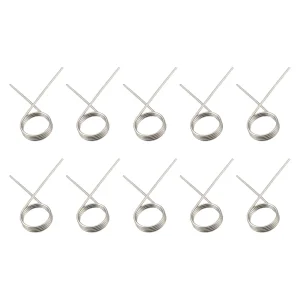Adjusting garage door spring tension is key for smooth and safe door operation. This article will cover the basics of garage door spring systems. It will also give step-by-step instructions for repair.
Whether you love DIY projects or just want to save on repairs, this guide is for you. We aim to make adjusting garage door springs easy for everyone. You’ll learn how to do it safely and effectively.
Our guide will show you how to spot and fix issues with spring tension. You’ll learn how to keep your garage door running well. We’ll also share tips on maintenance to make your garage door last longer.
Understanding Garage Door Spring Systems
Garage door spring systems are key to your garage door’s smooth operation. It’s important to know about the different garage door spring types and their roles. There are mainly two types: torsion springs and extension springs. Torsion springs sit above the door, while extension springs are on the sides.
The garage door spring function is to balance the door’s weight. This makes opening and closing easier. Knowing how these springs work is critical. Incorrect tension can cause problems like uneven movement, noise, and safety risks.
- Uneven movement of the garage door
- Noisy operation
- Difficulty opening or closing the door
Spotting these signs and understanding the garage door spring types helps you adjust the tension safely. Next, we’ll talk about important safety tips before you start adjusting the spring tension.
Critical Safety Warnings Before You Begin
Adjusting garage door spring tension is a task that requires garage door spring safety above all else. It can be dangerous if not done right. Always wear gloves and safety glasses to protect yourself.
To keep things safe, make sure the garage door is closed before you start. Never adjust the spring when the door is open or moving. It’s also key to know how your garage door spring system works and follow the maker’s instructions.
- Wearing protective gear, such as gloves and safety glasses
- Ensuring the garage door is securely closed before starting the adjustment process
- Never attempting to adjust the spring tension when the door is open or in motion
- Following the manufacturer’s instructions for adjustment and maintenance
By following these safety tips, you can adjust your garage door springs safely and effectively. Remember, garage door spring safety and garage door repair safety are always the most important when working on your garage door.
Essential Tools and Equipment for Spring Adjustment
To adjust the garage door spring tension, you’ll need the right tools and equipment. This includes safety gear, like gloves and safety glasses. You’ll also need adjustment tools, like a wrench and a ladder. Having the proper garage door spring adjustment tools and garage door repair equipment is key for a safe and successful adjustment.
Here are some of the essential tools and equipment you’ll need:
- Gloves and safety glasses for protection
- A wrench for adjusting the springs
- A ladder for accessing the springs
- A spring scale for measuring the spring tension
Optional equipment, like a spring scale, can also be useful for measuring the spring tension. It’s important to have the right tools and equipment for a safe and effective adjustment. By using the proper garage door spring adjustment tools and garage door repair equipment, you can avoid injuries and ensure a successful adjustment.
Always follow safety guidelines and use the proper tools and equipment when adjusting your garage door spring tension. This will help you avoid injuries and ensure a successful adjustment.
| Tool | Description |
|---|---|
| Gloves | Protect your hands from injuries |
| Safety glasses | Protect your eyes from debris |
| Wrench | Adjust the springs |
| Ladder | Access the springs |
| Spring scale | Measure the spring tension |
How to Adjust Tension on Garage Door Spring: Step-by-Step Process
To start the garage door spring adjustment process, you need to know the basics. This includes measuring tension, loosening springs, and tightening them to the right level.
The first step is to measure the current tension. Use a spring scale to find out how much weight the spring holds. Then, loosen the springs by removing the setscrews. But be careful not to remove too much tension, as it can make the spring unbalanced.
After loosening the springs, tighten them to the recommended level. Turn the setscrews clockwise to increase tension. It’s important to follow the manufacturer’s instructions for the right tension. Wrong tension can cause problems with your garage door.
Here are some important things to remember when adjusting your garage door spring’s tension:
- Always follow the manufacturer’s instructions for the recommended tension.
- Use a spring scale to measure the current tension.
- Loosen the springs carefully to avoid removing too much tension.
- Tighten the springs to the recommended tension by turning the setscrews clockwise.
By following these steps and remembering these key points, you can adjust your garage door spring correctly. This ensures your garage door works smoothly and safely.
Always put your safety first when working with garage door springs. If you’re unsure about any part of the process, consider getting professional help.
Measuring and Testing Spring Balance
Having the right garage door spring balance is key for safe and smooth operation. To check if the springs are balanced, you can measure and test them. You can use manual methods or spring scale tools for this.
Manual Testing Methods
Manual testing means lifting the garage door to see if it stays open or closes slowly. If it stays open, the springs might be too tight. But if it closes quickly, they might be too loose.
Using Spring Scale Tools
Spring scale tools give a precise reading of the spring balance. You attach them to the spring to measure the tension. This way, you can make sure the springs are balanced right, and the door moves smoothly.
Balance Indicators to Watch For
Look out for signs like a door that’s hard to open or close, or one that makes loud noises. These signs mean the springs might not be balanced right. You can fix this with spring scale tools.
By following these steps and using the right tools, you can keep your garage door’s spring balance correct. This ensures the door works smoothly.
| Testing Method | Description |
|---|---|
| Manual Testing | Lifting the garage door to check balance |
| Spring Scale Tools | Using tools to measure spring tension |
Common Mistakes to Avoid During Adjustment
Adjusting garage door spring tension requires careful steps to avoid garage door spring adjustment mistakes and common garage door repair mistakes. These errors can lead to an unbalanced door. This can cause accidents and harm the door and nearby structures.
To steer clear of these errors, it’s vital to stick to the right steps and safety measures. Common blunders include tightening springs too much or too little, using the wrong tools, and ignoring safety rules. Knowing these common mistakes helps ensure a safe and effective adjustment.
Here are some key mistakes to avoid:
- Not wearing proper safety gear, such as gloves and safety glasses
- Using the wrong tools, which can damage the springs or other components
- Not following the manufacturer’s instructions for adjustment and maintenance
Avoiding these mistakes ensures your garage door works safely and is balanced right. Always follow safety rules and the manufacturer’s guidelines when adjusting the springs. This way, you can avoid garage door spring adjustment mistakes and common garage door repair mistakes.
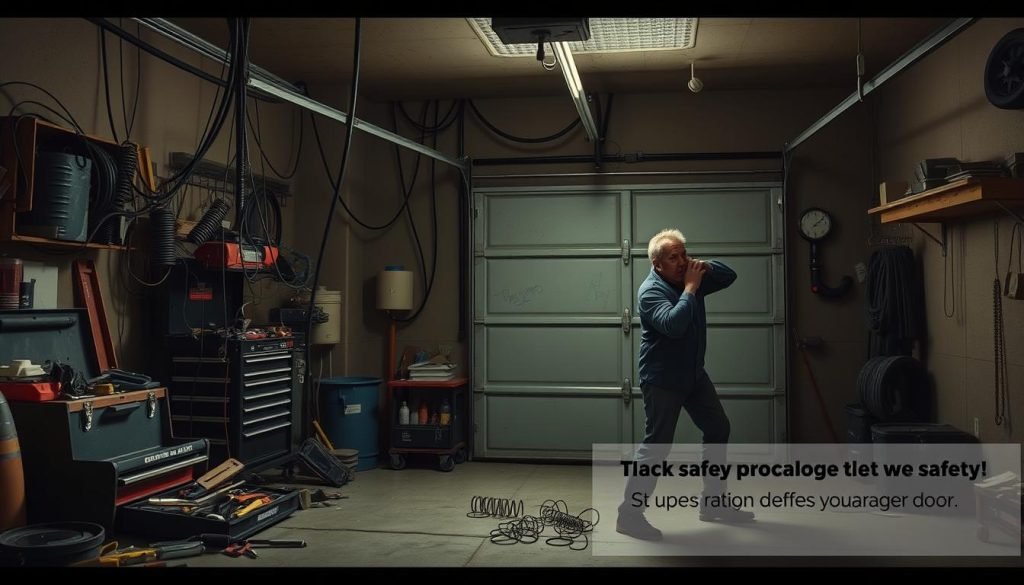
Regular maintenance is also key to preventing common garage door repair mistakes. By regularly checking and maintaining your garage door springs, you can spot issues early. This helps avoid major problems.
| Mistake | Consequence |
|---|---|
| Over-tightening the springs | Damage to the springs or surrounding structures |
| Under-tightening the springs | Improperly balanced door, leading to accidents |
| Not following safety guidelines | Personal injury or damage to the door and surrounding structures |
Troubleshooting Spring Tension Issues
Dealing with garage door spring tension issues can be tough. It’s key to spot the problem and fix it fast. With the right steps, you can make your garage door work smoothly and safely.
Common problems include a door that’s hard to lift, won’t stay open, or moves unevenly. Start by checking the spring tension and adjust it if needed.
Common Issues and Solutions
- Door too heavy to lift: Check the spring tension and adjust it to the recommended level.
- Door won’t stay open: Inspect the rollers and tracks for any damage or blockages and clean or replace them as needed.
- Uneven movement problems: Check the spring balance and adjust it to ensure even movement.
By following these steps, you can fix garage door spring tension issues. This ensures your garage door works well and safely. Always keep safety in mind when working with garage doors and springs.
Regular maintenance and checks can prevent spring tension issues. Being proactive helps your garage door last longer. This way, you can avoid problems and keep your door running smoothly.
| Issue | Solution |
|---|---|
| Door too heavy to lift | Adjust spring tension |
| Door won’t stay open | Inspect and clean rollers and tracks |
| Uneven movement problems | Check and adjust spring balance |
Maintaining Proper Spring Tension
Regular garage door spring maintenance is key for your garage door’s safety and life span. It’s important to check and adjust the spring tension often. Look for rust or corrosion on the springs and lubricate them to keep them working well.
Here are some tips for keeping the spring tension right:
- Regularly check the springs for wear and tear
- Use lubricant to keep the springs moving smoothly
- Adjust the tension to keep the door balanced
By following these steps, your garage door will run smoothly and safely for many years. Keeping the spring tension correct is vital to avoid accidents and make your garage door last longer.
It’s also smart to keep a log of your maintenance work. Note the date and type of maintenance done. This helps you stay on schedule and ensures your garage door works well. By focusing on garage door spring maintenance and maintaining proper spring tension, you’ll have a safe and reliable garage door for years.
| Maintenance Activity | Frequency |
|---|---|
| Inspecting springs | Every 3 months |
| Lubricating springs | Every 6 months |
| Adjusting tension | As needed |
When to Call a Professional
Adjusting garage door spring tension can be a DIY task. But, there are times when it’s best to call a professional. Garage door spring repair experts have the skills and experience for complex issues. If you’re unsure, it’s safer to get professional help.
Before deciding to call a professional, consider these factors:
- Risk assessment: Think about the risks of adjusting the spring tension yourself. If it feels too complex, it’s best to call a professional.
- Cost considerations: Calling a professional might seem expensive. But, it can save you money in the long run. A pro can do the job right, avoiding future repairs or replacements.
- Finding qualified technicians: Look for garage door spring repair experts who are licensed, insured, and have a good reputation. Ask friends or family for referrals, or check online reviews to find a reliable technician.
Deciding when to call a professional is key for your safety and property. By considering these factors and seeking help when needed, you can avoid risks. This ensures your garage door works properly.
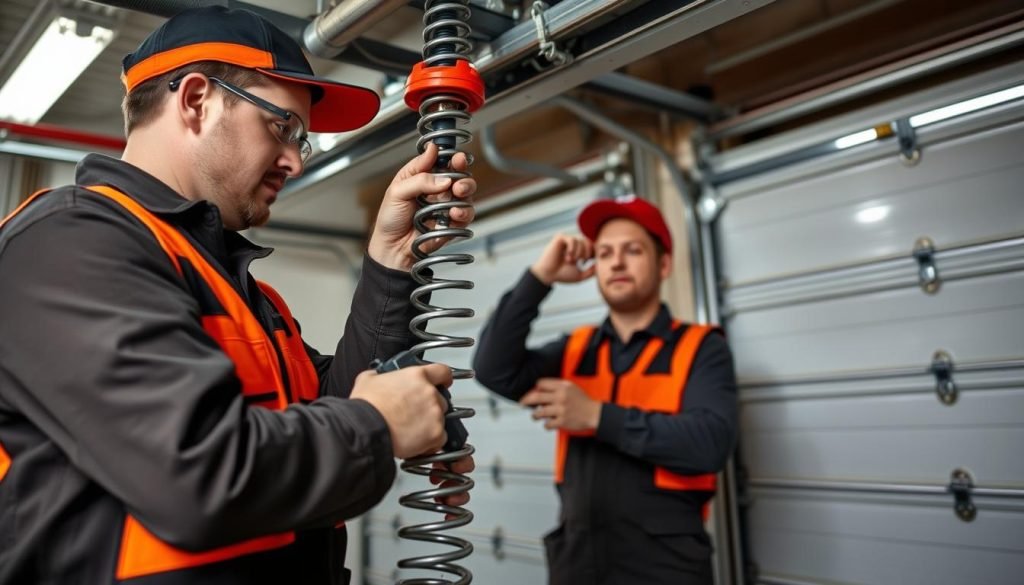
If you’re ever unsure about adjusting your garage door spring tension, call a professional. They can offer the expertise and guidance you need. This ensures the job is done correctly and safely.
Additional Spring Care Tips
Proper care of your garage door springs is key to keeping your door working well. It’s important to check and adjust the spring tension regularly. Also, following a seasonal maintenance schedule is vital. This includes checking and oiling the springs to stop rust and corrosion.
Having a good seasonal maintenance schedule helps spot problems early. It can include tasks like:
- Spring inspection and lubrication
- Summer cleaning and maintenance
- Fall preparation for extreme weather conditions
- Winter checks for proper door function
Preventive Measures
To keep your garage door springs in top shape, think about adding a spring protection system. This can prevent damage to the springs and other parts.
By sticking to a detailed garage door spring care plan, you can have a door that works smoothly for many years.
| Season | Maintenance Tasks |
|---|---|
| Spring | Inspect and lubricate springs, clean door tracks |
| Summer | Clean and maintain door components, check spring tension |
| Fall | Prepare for extreme weather, inspect door seals |
| Winter | Check door function, apply lubricant to moving parts |
Conclusion: Ensuring Long-Term Garage Door Performance
As we wrap up this guide, the secret to a long-lasting garage door is in the spring tension. By following our step-by-step guide and staying safe, you can adjust your garage door springs perfectly. This makes your door work smoothly and last longer.
Don’t forget, regular checks, timely oil, and quick fixes are key. They help keep your garage door’s performance and long-term maintenance top-notch. With the right care, your garage door will keep your home safe and accessible for many years.
Learning to adjust spring tension makes you a smart DIY homeowner. You should feel proud of yourself for keeping your garage door in top shape. Now, you’re ready to take on more home projects and keep your place running smoothly.

